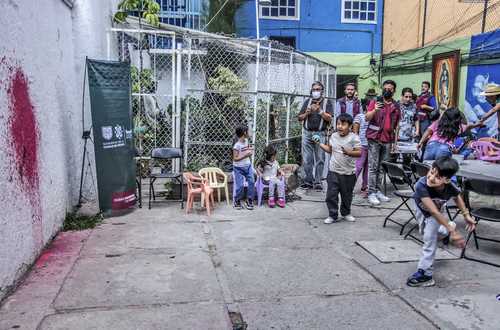There are about 20 children who live in the rough neighborhood, “great readers of reality”, who four months ago approached the Tepito Arte Acá collective, directed by Virgilio Carrillo to do a workshop and approach the various arts and express their talent.
With this initiative, explained Carrillo, founding director of the group, it was confirmed that the children, aged between three and nine, “despite living in a violent or marginal neighbourhood, have another way of expressing themselves; Many of them are very talented and may be actors, or they may be into printmaking, clay art, drawing, storytelling or playing pre-Hispanic music; that is to say, they cover different things because they are eager for creative capacity and when they do, they configure a space of freedom”.
This is how Carrillo recounted the experience: “Tons, but with 22-year-olds? Well, here they are at no. 22 in one street or another in the Tepito neighborhood, there they are; They show themselves, they introduce themselves, they walk through the courtyard which is the place of life and death, where one day there is the vigil and the next the wedding”.
Yes, “here they are in that patio where they learn to dance, to choose, to be carnal, to be ñeros or hooligans; they are libertarian, supportive and sometimes puny children; Being from Tepito gives them a watchword, makes them part of this territory, of this long and bloody 500-year history. They roam the same places where Cuauhtémoc and Cuitláhuac met, where the tepochcalli was, where the last battles against the Spanish took place.
Here they are, continued Carrillo, “these children who play, meet, establish relationships of carnalism, challenge reality with high-sounding words, but with genuine loyalty. We have arrived at that patio with the so-called creative workshops and they realize the ability they have to create with their hands, to narrate, to invent stories and characters, giving life to a culture of storytellers who know how to dream, think and be. ñeroswith the awareness that being Wild man it is being in solidarity, being “here” on this side of marginalization, despite the neglect of the state, they are there, they know how to dance and send whatever annoys them to hell”.
The little ones, highlighted the director, “lived with Itzel Cornejo as a companion, with Diana Reséndiz, with Susana Meza who gave coherence to this project, with Alfonso Sarquiz, an inveterate salesman who sells everything except dignity and collaborates so that in the end there is a harmonious and abundant snack, just like with Mayra Valenzuela who emerged from the hosts of the CGH who now has an island of peace in Peralvillo #22”.
The workshop will happily close with a posada on December 17 at Peralvillo #22, in the context of the Posada por la Paz, “where friends will show solidarity and bring Pastorela, hip hop music, standing and traditional art; In addition, the Historic Center Authority, led by Manuel Oropeza, will support us with food and the locals with piñatas.”
In reality, underlined Virgilio Carrillo, “in addition to the laboratory, it became a community and people participated in solidarity”. Also, he said, the Cultural Center of Contemporary Mexico, located at Leandro Valle 20, has offered the children a space to exhibit their work done in the workshop in the coming weeks.
More than 40 years after its foundation, Tepito Arte Acá has dedicated itself to “recovering memory, identity and telling kids that theater doesn’t hurt them and it’s also fun”; They also offer workshops on various artistic expressions, emphasizing socialization work focused on children and young people, through performances in schools, workshops and performances.
Now, highlighted Carrillo, “the public has been recovered at the Jorge Negrete theater”, where today in the San Rafael neighborhood the company will perform at 10 with the show Kill them hot! and at 12:30 with Juárez or the Republic.


